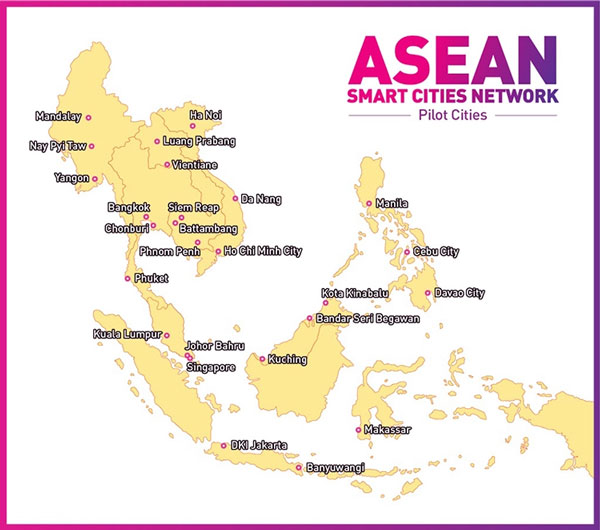SOME of the fastest-growing cities in the world can be found in the Asean region. By 2025, it is predicted that around 62.5% (or approximately 230 million people) of Asean region’s population will reside in urban centres and cities.
Naturally, fast urbanisation causes congestion, water shortages, a lack of public services, rising disparities, a lack of safety and security, and other issues that necessitate better infrastructure to ensure that expansion is sustainable.
A key document in the Asean Smart Cities Network (ASCN) is the Asean Smart Cities Framework. Three distinct outcomes are sought after by the framework: A high quality of life, a competitive economy and a sustainable environment.
To achieve the aforementioned strategic outcomes, it is essential that digital infrastructure and applications serve as enablers that collaborate with urban systems like integrated master planning and development and urban governance to support and accelerate the development of focus areas (such as health and wellbeing, civil and social aspects, built infrastructure, among others).
Malaysia has announced MySmart Wilayah 2030, a smart city blueprint for federal territories that aspires to employ digital technologies for smart urban planning and development. The project intends to improve the people’s quality of life in areas like as education, security, health, a clean environment, and an efficient transportation system.
Vietnam presided over the ASCN in 2020, when the global Covid-19 epidemic emerged. Ten provinces and cities in Vietnam have now developed and authorised smart city initiatives. Da Nang, Hanoi and Ho Chi Minh City are the three cities in Vietnam that have been nominated as Pilot Cities by their respective Asean member states.
These expanding metropolitan centres would also serve as economic engines fuelling the national and Asean-wide economic expansion.
Utilising technology remains essential for overcoming obstacles and constructing an infrastructure that is both enhanced and sustainable to fulfil the needs of both today and tomorrow. However, currently the programmes are solely focused on fostering the expansion of information technology infrastructure, as opposed to investing in technological infrastructure.
Although the goals for smart cities are lofty, the recent abandonment of some smart city pilot programmes has prompted introspection. These projects are frequently criticised for focusing excessively on technology and not enough on problem-solving.
So, what is needed are real-world problems that technology can solve so that people can live healthier lives.
Industry 4.0 — with its multitude of disruptive technologies such as cyber-physical systems, 5G networks, robots, artificial intelligence, cloud computing and a host of others — may provide the solutions necessary to deliver integrated and responsive public services.
In addition, the efficient and sustainable management of energy transmission, trash, public transportation, health, education and innovation, government and citizen involvement would go a long way toward improving quality of life in a clean, green and liveable environment. For instance, if the construction sector’s efficiency could be increased through better digitisation and intelligent solutions, this would considerably strengthen the global economy.
Smart cities’ reliance on technology draws hackers and cybercriminals who could cause widespread disruptions. As a result of the current Covid-19 epidemic, such instances are on the rise.
To prevent such crimes, a high degree of cybersecurity measures employing the most advanced and innovative solutions must be implemented. Moreover, tech-driven integrated and connected cities should not become a surveillance tool, and people should be able to rest certain that their privacy is not compromised and they are not being tracked at every turn.
ASCN seeks to establish a resilient society with a vibrant economy that provides abundant employment and entrepreneurial possibilities in healthy ecosystems for the wellbeing of all people. Urban systems serve as the foundation for coordinating smart urbanisation with regulatory frameworks.

Currently, 26 Asean pilot cities have been selected for the ASCN initiative, which aims to make these towns more sustainable and liveable.
For the effective management of resources, however, there is a need for enhanced participation from various stakeholders. Private-public partnership could play a vital role in this situation. However, the implementation requires enabling factors such as technology, partnerships and funding.
Participatory governance of smart cities necessitates the participation of multiple stakeholders. One of the current arguments posits that socioeconomic, cultural and technical equilibrium necessitates the implementation of a form of urbanisation embedded in knowledge-based innovation systems. The Triple Helix model proposes that the relationships between universities, government and industry regulate the knowledge economy.
For the plans of action to be transformed into effective governance and the development of resilient and sustainable communities, there must be a strong relationship with the business sector. These plans of action must also be aligned with the existing urbanisation strategy outlined in the Asean Connectivity 2025 Plan in order to generate reciprocal advantages.
------
Dr Sameer Kumar is an associate professor Universiti Malaya’s Asia-Europe Institute.
----
Article was first published at The Malaysian Reserve.
Last Update: 03/10/2022